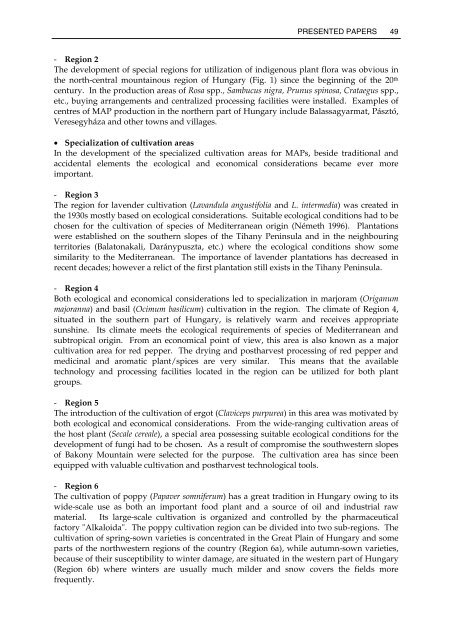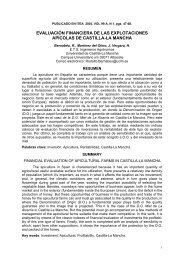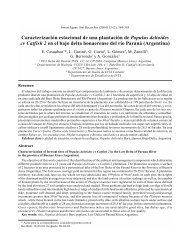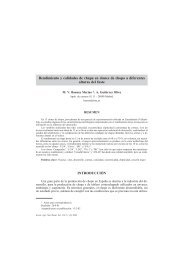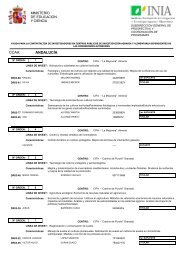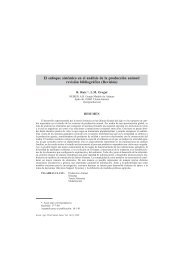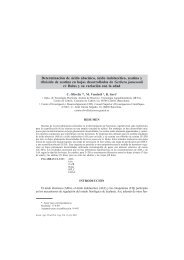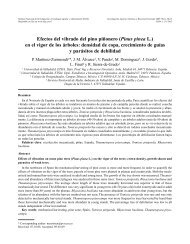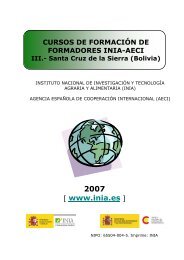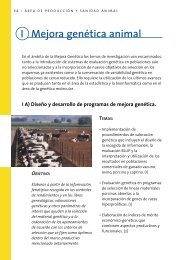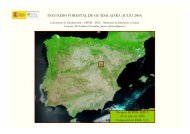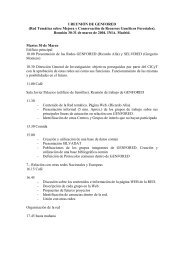Status of medicinal and aromatic plants in - Inia
Status of medicinal and aromatic plants in - Inia
Status of medicinal and aromatic plants in - Inia
You also want an ePaper? Increase the reach of your titles
YUMPU automatically turns print PDFs into web optimized ePapers that Google loves.
PRESENTED PAPERS 49<br />
- Region 2<br />
The development <strong>of</strong> special regions for utilization <strong>of</strong> <strong>in</strong>digenous plant flora was obvious <strong>in</strong><br />
the north-central mounta<strong>in</strong>ous region <strong>of</strong> Hungary (Fig. 1) s<strong>in</strong>ce the beg<strong>in</strong>n<strong>in</strong>g <strong>of</strong> the 20 th<br />
century. In the production areas <strong>of</strong> Rosa spp., Sambucus nigra, Prunus sp<strong>in</strong>osa, Crataegus spp.,<br />
etc., buy<strong>in</strong>g arrangements <strong>and</strong> centralized process<strong>in</strong>g facilities were <strong>in</strong>stalled. Examples <strong>of</strong><br />
centres <strong>of</strong> MAP production <strong>in</strong> the northern part <strong>of</strong> Hungary <strong>in</strong>clude Balassagyarmat, Pásztó,<br />
Veresegyháza <strong>and</strong> other towns <strong>and</strong> villages.<br />
• Specialization <strong>of</strong> cultivation areas<br />
In the development <strong>of</strong> the specialized cultivation areas for MAPs, beside traditional <strong>and</strong><br />
accidental elements the ecological <strong>and</strong> economical considerations became ever more<br />
important.<br />
- Region 3<br />
The region for lavender cultivation (Lav<strong>and</strong>ula angustifolia <strong>and</strong> L. <strong>in</strong>termedia) was created <strong>in</strong><br />
the 1930s mostly based on ecological considerations. Suitable ecological conditions had to be<br />
chosen for the cultivation <strong>of</strong> species <strong>of</strong> Mediterranean orig<strong>in</strong> (Németh 1996). Plantations<br />
were established on the southern slopes <strong>of</strong> the Tihany Pen<strong>in</strong>sula <strong>and</strong> <strong>in</strong> the neighbour<strong>in</strong>g<br />
territories (Balatonakali, Daránypuszta, etc.) where the ecological conditions show some<br />
similarity to the Mediterranean. The importance <strong>of</strong> lavender plantations has decreased <strong>in</strong><br />
recent decades; however a relict <strong>of</strong> the first plantation still exists <strong>in</strong> the Tihany Pen<strong>in</strong>sula.<br />
- Region 4<br />
Both ecological <strong>and</strong> economical considerations led to specialization <strong>in</strong> marjoram (Origanum<br />
majoranna) <strong>and</strong> basil (Ocimum basilicum) cultivation <strong>in</strong> the region. The climate <strong>of</strong> Region 4,<br />
situated <strong>in</strong> the southern part <strong>of</strong> Hungary, is relatively warm <strong>and</strong> receives appropriate<br />
sunsh<strong>in</strong>e. Its climate meets the ecological requirements <strong>of</strong> species <strong>of</strong> Mediterranean <strong>and</strong><br />
subtropical orig<strong>in</strong>. From an economical po<strong>in</strong>t <strong>of</strong> view, this area is also known as a major<br />
cultivation area for red pepper. The dry<strong>in</strong>g <strong>and</strong> postharvest process<strong>in</strong>g <strong>of</strong> red pepper <strong>and</strong><br />
<strong>medic<strong>in</strong>al</strong> <strong>and</strong> <strong>aromatic</strong> plant/spices are very similar. This means that the available<br />
technology <strong>and</strong> process<strong>in</strong>g facilities located <strong>in</strong> the region can be utilized for both plant<br />
groups.<br />
- Region 5<br />
The <strong>in</strong>troduction <strong>of</strong> the cultivation <strong>of</strong> ergot (Claviceps purpurea) <strong>in</strong> this area was motivated by<br />
both ecological <strong>and</strong> economical considerations. From the wide-rang<strong>in</strong>g cultivation areas <strong>of</strong><br />
the host plant (Secale cereale), a special area possess<strong>in</strong>g suitable ecological conditions for the<br />
development <strong>of</strong> fungi had to be chosen. As a result <strong>of</strong> compromise the southwestern slopes<br />
<strong>of</strong> Bakony Mounta<strong>in</strong> were selected for the purpose. The cultivation area has s<strong>in</strong>ce been<br />
equipped with valuable cultivation <strong>and</strong> postharvest technological tools.<br />
- Region 6<br />
The cultivation <strong>of</strong> poppy (Papaver somniferum) has a great tradition <strong>in</strong> Hungary ow<strong>in</strong>g to its<br />
wide-scale use as both an important food plant <strong>and</strong> a source <strong>of</strong> oil <strong>and</strong> <strong>in</strong>dustrial raw<br />
material. Its large-scale cultivation is organized <strong>and</strong> controlled by the pharmaceutical<br />
factory "Alkaloida". The poppy cultivation region can be divided <strong>in</strong>to two sub-regions. The<br />
cultivation <strong>of</strong> spr<strong>in</strong>g-sown varieties is concentrated <strong>in</strong> the Great Pla<strong>in</strong> <strong>of</strong> Hungary <strong>and</strong> some<br />
parts <strong>of</strong> the northwestern regions <strong>of</strong> the country (Region 6a), while autumn-sown varieties,<br />
because <strong>of</strong> their susceptibility to w<strong>in</strong>ter damage, are situated <strong>in</strong> the western part <strong>of</strong> Hungary<br />
(Region 6b) where w<strong>in</strong>ters are usually much milder <strong>and</strong> snow covers the fields more<br />
frequently.


